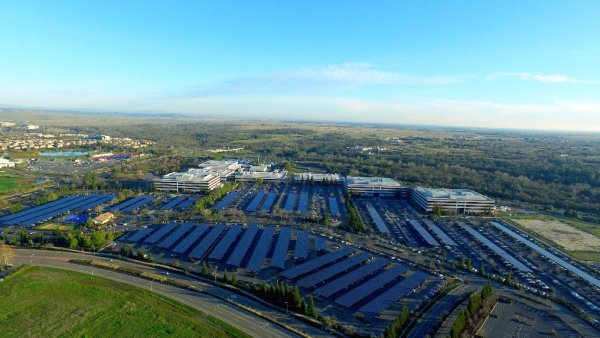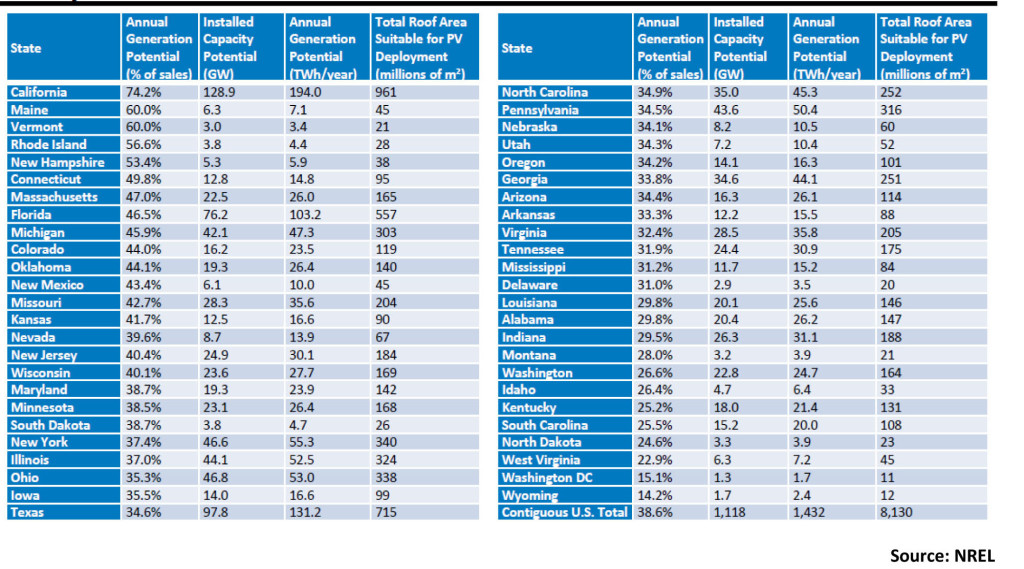It’s pie-in-the-sky by design, but a new report from DOE’s National Renewable Energy Laboratory on the technical potential of rooftop solar in the U.S. is eye-opening nonetheless. All told, NREL said, some 1,118 gigawatts (GW) of capacity could be installed if all the “suitable” rooftops in the U.S. were covered with PV panels, generating upward of 1,432 terawatt-hours (TWh) of electricity annually—roughly 39 percent of total annual electric sales.
NREL is quick to point out that the study, Rooftop Solar Photovoltaic Potential In The United States (which can be found here), did not look at economics. As such, the study represents “an upper bound on potential deployment rather than a prediction of actual deployment.” But even on this basis, the study found that solar’s potential has expanded significantly in the past decade: A similar study on solar PV’s technical potential that NREL completed in 2008 estimated that 664 GW of rooftop capacity could be installed, generating roughly 880 TWh of electricity annually. The difference between the two estimates, NREL wrote, “can be attributed to increases in module power density, improved estimation of building suitability, higher estimates of the total number of buildings, and improvements in PV performance simulation tools that previously tended to underestimate production.”
Taking that statement at face value, it is almost certain that PV’s technical potential is going to continue rising in the years to come. In particular, NREL noted that its analysis is based on an assumed module efficiency of 16 percent; a figure it used to better represent a mixture of installed systems, not just premium PV panels. If the analysis had assumed a module efficiency of 20 percent, which is where premium systems are today, “each of the technical potential estimates would increase by about 25 percent above the values stated in this report,” NREL wrote.
It’s not a given, but if NREL returns to this analysis in another five years, 20 percent module efficiency may well be the everyday standard, with premium modules even higher. SolarCity and other competitors have been slugging it out to lay claim to the title of most efficient module, and Panasonic, SolarCity and SunPower all tout their ability to top the 22 percent mark already for their best-in-class modules. What the average efficiency of the standard will be in five years is anyone’s guess, but 16 percent efficient modules are likely to have been consigned to the remainder bin.
The results in the NREL study also do not incorporate any estimates for what the lab dubbed the “immense potential of ground-mounted PV.” And, fittingly, as I was pulling together the research for this piece, Intel announced the completion of what it says is the largest privately owned PV carport in the U.S. The sprawling facility (see the Intel PR picture below) at the company’s Folsom, Calif., campus will be able to produce 6.5 MW of electricity during peak production, as well as providing shade for some 3,000 vehicles. Immense potential indeed.
Digging into the specifics of NREL’s new report yields some interesting findings, both on the national scale and regarding particular states. For example, California has long been the leading player in solar energy, with more than 12,000 MW of installed capacity according to the Solar Energy Industries Association. In addition, the Energy Information Administration noted last year that California had passed a milestone in 2014—becoming the first state to get 5 percent of its utility-scale electric generation from solar power. Despite these strong results, there is significant room for continued growth: NREL estimates that rooftop PV installations in California “could generate 74 percent of the electricity sold by its utilities in 2013.” Now that’s potential….
But the potential is not limited to California and the sunny Southwest. Despite the region’s “below-average solar resource,” NREL estimates that the six New England states could offset at least 45 percent of their annual electricity needs through PV generation. In part this is due to the region’s relatively low per capita electricity consumption, driven in turn by the high percentage of winter heating provided by natural gas and fuel oil and the relatively low summer cooling needs. Still, the potential is clearly there.
Conversely, even though average household consumption in Florida is 130 percent of the national average, NREL still estimates that the state could meet 47 percent of its annual consumption through rooftop PV. “This is largely explained,” NREL said, “by significantly below-average electricity consumption outside of the residential sector, which makes the state’s total per-capita electricity sales slightly lower than the national average.” The Sunshine state’s solar resource is also, not surprisingly, high quality and the state has a high percentage of buildings with PV potential. These findings give added import to the ongoing fight in Florida over small-scale solar development.
All told, NREL found that 45 of the 48 states in the continental U.S. (see chart below) had the potential to generate 25 percent or more of their annual electricity needs with rooftop PV. The three states below that level are North Dakota (24.6 percent), West Virginia (22.9 percent) and Wyoming (14.2 percent). Wyoming is at the bottom of the list largely because it has the highest per capita electricity consumption of any state, 30.3 megawatt-hours/year (some 250 percent of the national average), because of high industrial electricity use. Washington, D.C., is also at the tail end of the list (at 15.1 percent), largely because of its small geographic footprint, which means that there simply aren’t have enough developable rooftops to offset the city’s electricity consumption.
TOTAL ROOFTOP PV POTENTIAL–ALL BUILDINGS BY STATE
The report also sorts the nation’s PV potential by building size, and here small is definitely the big winner. According to NREL, small building rooftops (those with a footprint of less than 5,000 square feet) could host 731 GW of PV capacity and generate 926 TWh of electricity annually—almost two thirds of the total. Interestingly, only 26 percent of the total rooftop area on small buildings is PV friendly, but because of the sheer number of buildings in this class the potential is prodigious.
Pie-in-the-sky perhaps, but a clear indicator of where we can go. And a sure indication that despite the soaring growth of the past several years—SEIA and GTM Research just announced today that the U.S. installed a record 7,286 MW of new PV capacity in 2015—there are plenty of rooftops still waiting for their PV panels.
–Dennis Wamsted


 Follow
Follow